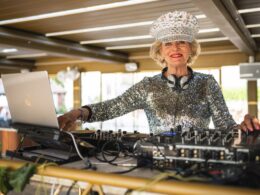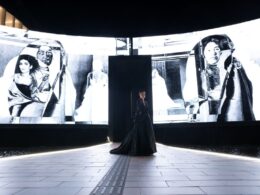How did you first become interested in working in fashion and how has your journey as a fashion artisan evolved since then?
I think having parents that are very much into Italian fashion and seeing them always nicely dressed kind of instilled in me a certain love for clothing since I was a little girl, but as I grew older, it became my way of expressing myself. The love for vintage and old pieces was something that always interested me – I remember always going through my grandma’s stuff and loving the design and fabrics.
Going abroad, I was always attracted to the markets and thrifting stores and thankfully Malta’s vintage and second hand thrifting scene started to slowly and grow, becoming what it is today. My style evolved and merged all in one over time. It probably started with the 1960s and 70s style, and then grew into a bit of an earthy touch thanks to the cultures and countries visited round Asia.
Where do you source your materials?
My collection is a combination of ethnic and vintage pieces. My ultimate favourite are the vintage garments from India, Nepal and Tibet. The idea of selling my used clothes was a habit even before using Instagram.
I’ve been hunting and collecting vintage garments for almost 15 years, and my storage space was running very low. Added to this, when I was travelling I had to pack all my stuff in boxes as my parents were downsizing and I opted for a mobile home upon settling back here. Tiny living definitely wasn’t ideal for all those stored vintage items, so I decided to do something about it. I also had some jewellery and other stuff from my travels, and slowly Samsara Finds came to life.
Do you design and create your own pieces or do you source readymade items?
Unfortunately, I am not able to design my own pieces. I do have a lot of ideas, but not the skill to design or create the item. In fact, any talented humans out there that would like to bring my ideas to life, do drop me a message. My items are all readymade, found during my hunts. I sometimes take them to my tailor to fix, alter or repurpose.
For now, the recent finds are all local, and the old stock from my past hunts is a mix of wherever I find something special. The pandemic and having a baby slowed things down, as my priorities shifted, but I’m slowly getting back into the swing of things. The goal is to keep up the search for unique one-off pieces that are not only locally-sourced, but also hail from other cultures and places that hold so much beauty.


What sets your business apart from other vintage and upcycled fashion retailers in the local market?
I believe that all the thrifters and local markets have their own special items, as everyone has their own style and eye. The beauty of this sector is that most of the items are one-off, meaning that you wouldn’t find the same piece from another vintage store which makes every seller unique and with their own identity.
What are the most pressing issues facing the fashion industry in terms of sustainability, and how does your business model address these concerns?
The what I like to call the fast fashion monster that overlooks humanitarian and environmental issues. Fast fashion is linked to child labour, poor wages, bad working conditions, not to mention the negative impact it has on the environment. The more we consume, the greater the negative impact. Landfills are overflowing with unwanted garments, not to mention the resources needed to keep up with the demand.
This is why I strongly suggest to reduce your shopping frenzy and instead swap, upcycle, fix, alter and be creative and out of the habit of tossing clothes away when they tear or are not seen as fashionable anymore.
Don’t let social media bombard and brainwash you – it’s your style, own it. Donate ones that do not fit or you’ve outgrown so that they can be given some new loving. As for buying new clothes – know your brands. This prevents you from unintentionally ending up supporting unethical brands, ones that do not care about fair trade or the environment.
I love clothes, but I also love this planet. What started as a hobby and for style in my teens has developed into something I feel strongly about. A platform like mine, and the numerous charity and thrifting places help keep vintage pieces alive, which not only pay tribute to the beautiful eras before fast fashion took over, but also to be part of circular fashion. Swapping and buying second hand is a super way of looking good without spending too much, reducing consumption from big labels and helping the environment.
Can you share some examples of successful collaborations or partnerships you’ve had with other like-minded businesses or organisations that focus on sustainability?
I’ve been part of some pretty cool markets like Popp and Bloom. I’ve also been in different pop-up shops like the ones held by Il-Lokal and Nicole Paris at Desko Gallery. All of these events cherish and promote sustainability and work hard to promote local, secondhand and handmade goods.
You can view and purchase Samsara Finds collections here. For other Pink Magazine fashion pieces, check out this piece about the Pink Fashion Show and this feature about Parascandalo‘s new Naxxar outlet.










